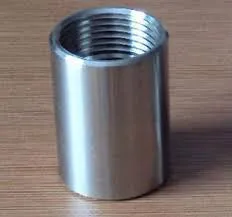-
Cangzhou Yulong Steel Co., Ltd.
-
Phone:
+86 13303177267 -
Email:
admin@ylsteelfittings.com

Dec . 05, 2024 14:18 Back to list
sanitary weld fittings
Understanding Sanitary Weld Fittings Essential Components in Hygiene and Safety
Sanitary weld fittings are critical components commonly used in the food, beverage, pharmaceutical, and biotechnology industries, where hygiene and safety are non-negotiable. These fittings are designed to create secure connections between pipes and equipment while ensuring that the flow of materials is uncontaminated. With increasing emphasis on cleanliness and efficiency, understanding the importance, types, and applications of sanitary weld fittings is essential for professionals in these fields.
The Importance of Sanitary Weld Fittings
In industries where hygiene is paramount, sanitary weld fittings play a pivotal role. These fittings are typically made of stainless steel, specifically grades like 304 or 316, which offer excellent corrosion resistance and meet the stringent regulatory requirements of food and pharmaceutical processing. The seamless design of these fittings minimizes the possibility of bacteria growth, ensuring that the internal surfaces are smooth and easy to clean. The proper use of sanitary fittings can significantly reduce contamination risks, which is crucial for maintaining product integrity and safety.
Key Characteristics of Sanitary Weld Fittings
1. Material Composition As mentioned earlier, most sanitary weld fittings are made from high-grade stainless steel. The choice of material is vital, as it impacts durability, corrosion resistance, and overall hygiene.
2. Seamless Design Unlike standard pipe fittings that may have joints, sanitary fittings are often produced as seamless to prevent any areas where contaminants can accumulate. This is crucial for maintaining sanitary conditions during processing.
3. Polished Surface The interiors of sanitary fittings are usually polished to a specific finish (often 180 or 240-grit) to minimize surface roughness. This smooth finish is vital for cleaning and maintaining sanitary conditions, as rough surfaces can harbor bacteria.
4. Variety of Configurations Sanitary weld fittings come in various configurations including elbows, tees, reducers, and caps. Each configuration is designed to facilitate specific flow paths in a piping system.
Types of Sanitary Weld Fittings
Sanitary weld fittings are categorized based on their design and application needs. Here are some common types
- Sanitary Elbows These fittings allow for directional changes in a piping system, typically at 45 or 90 degrees
.sanitary weld fittings

- Sanitary Tees These provide junctions for piped lines, allowing the flow to split between two paths or to combine flows.
- Sanitary Reducers These fittings help transition between different pipe sizes, enabling efficient flow management across varied pipe systems.
- Sanitary Caps Caps are used to seal the end of a pipe for maintenance and cleaning purposes.
Applications of Sanitary Weld Fittings
Sanitary weld fittings are utilized in a diverse array of applications within various industries. In the food industry, they are instrumental in processing and transporting liquids, including milk, beer, and juices. The pharmaceutical sector relies on these fittings for the manufacture of medicines where sterility is vital. Likewise, biotech applications often require the use of sanitary fittings to maintain controlled environments.
Choosing the Right Sanitary Weld Fittings
Selecting the appropriate sanitary weld fittings involves considering several factors
1. Compatibility with Existing Systems The material and size of the fittings must be compatible with the existing piping system.
2. Regulatory Compliance It’s crucial to ensure that the fittings meet industry standards and regulatory requirements, such as those set by the FDA or 3A Sanitary Standards.
3. Application-Specific Needs Depending on the specific application, factors like temperature, pressure, and the type of material being transported will influence the choice of fittings.
Conclusion
In summary, sanitary weld fittings are indispensable components that ensure the safe and hygienic transport of materials in various industries. Their design principles focused on cleanliness and efficiency reflect the growing demand for high standards in food, beverage, and pharmaceutical processing. Understanding the characteristics, types, and applications of these fittings helps industry professionals make informed decisions, ultimately leading to safer products and processes. As technologies advance, the sustainability and innovation in sanitary fitting design will continue to play a vital role in meeting the evolving demands of hygiene and safety standards across sectors.
Latest news
-
ANSI 150P SS304 SO FLANGE
NewsFeb.14,2025
-
ASTM A333GR6 STEEL PIPE
NewsJan.20,2025
-
ANSI B16.5 WELDING NECK FLANGE
NewsJan.15,2026
-
ANSI B16.5 SLIP-ON FLANGE
NewsApr.19,2024
-
DIN86044 PLATE FLANGE
NewsApr.19,2024
-
DIN2527 BLIND FLANGE
NewsApr.12,2024
-
JIS B2311 Butt-Welding Fittings LR/SR 45°/90° /180°Seamless/Weld
NewsApr.23,2024
-
DIN2605-2617 Butt-Welding Fittings LR/SR 45°/90°/180° Seamless/Weld
NewsApr.23,2024











